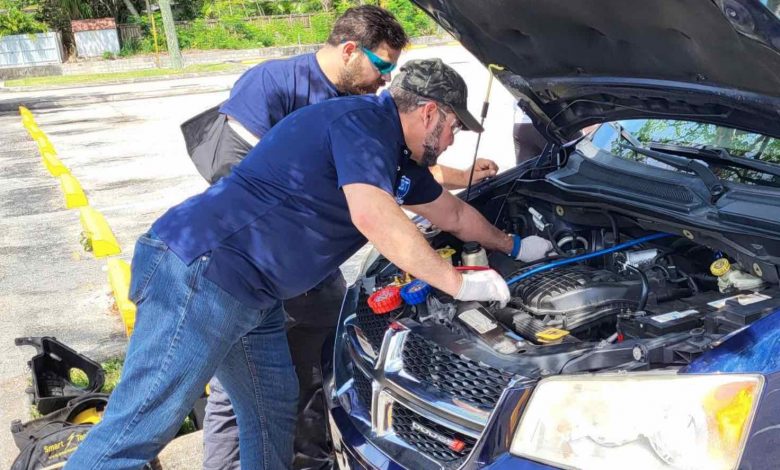
Will Artificial Intelligence Affect Trade Workers?
The rise of artificial intelligence (AI) has sparked fears among many workers, especially those with repetitive, manual labor jobs. They worry that AI-powered machines could automate their tasks, rendering their skills obsolete and potentially leading to job losses.
The picture is less clear for skilled trade workers, whose roles demand technical knowledge, problem-solving skills, and manual dexterity. Will AI render them obsolete, or can the two forces work together?
For most skilled trades, the answer to how artificial intelligence will affect trade workers lies not in job replacement but in transformation. AI is poised to revolutionize the skilled trade landscape, creating a dynamic partnership between humans and machines.
This post will explore the rise of human-machine partnerships in skilled trades, specifically focusing on how AI might impact specific industries such as heating, ventilation, and cooling (HVAC), electrical, and information technology (IT), three of the most popular Florida skilled trades.
HVAC Technicians: Using AI as a Predictive Partner
Imagine an HVAC technician arriving at your home with a toolbox and a tablet displaying a virtual map of your entire HVAC system. This map, generated by AI, analyzes data from your thermostat and smart sensors, pinpointing potential issues before they cause a breakdown. This is just one way AI can empower HVAC technicians.
Here are some others:
- Predictive maintenance: AI algorithms can analyze vast amounts of data from sensors in heating and cooling systems, identifying subtle changes that might indicate an impending malfunction. This allows technicians to schedule preventative maintenance, saving homeowners from unexpected breakdowns and costly repairs.
- Remote diagnostics: AI-powered tools can allow technicians to remotely diagnose problems based on data collected from smart thermostats and other connected devices. This can save time and resources, allowing them to prioritize urgent on-site visits.
- Augmented reality support: Imagine a technician wearing AR glasses that overlay schematics and real-time data on their view of your ductwork. This can provide crucial information on location and potential issues, leading to faster and more accurate repairs.
Electricians: Using AI as a Troubleshooting Assistant
Electrical problems can be complex and time-consuming to diagnose. Here’s how AI can step in and become a valuable partner for electricians:
- Smart fault detection: AI-powered diagnostic tools can analyze electrical panels and circuit data, pinpoint potential faults, and reduce troubleshooting time. This can be particularly valuable in complex wiring systems or intermittent electrical issues.
- Code compliance guidance: Staying up to date on ever-evolving electrical codes can be challenging. AI-powered tools can provide real-time guidance on code requirements, ensuring electricians complete installations safely and according to regulations.
- Safety first with AI-powered risk assessment: AI can analyze data on electrical loads and identify potential safety hazards before they occur. This proactive approach can prevent accidents and ensure the safety of both electricians and homeowners.
IT Professionals: Using AI as an Automation Ally
The world of IT is constantly evolving, and AI can be a powerful tool for IT professionals.
Here’s how:
- Automated patch management: Patching software vulnerabilities can be time-consuming. AI can automate the process, freeing IT professionals to focus on more strategic projects.
- Enhanced security with AI-powered threat detection: AI algorithms can analyze network traffic and user behavior patterns, identifying potential security threats in real time. This allows IT professionals to respond quickly and prevent cyberattacks.
- Help desk support with AI chatbots: AI-powered chatbots can handle routine help desk inquiries, freeing IT professionals to address more complex technical issues.

Challenges and the Road Ahead
While AI offers exciting possibilities for trade workers, there are also challenges to consider:
- Job displacement: While widespread replacement is unlikely, some routine tasks within these trades might become automated. This could affect entry-level positions or those focused on specific, repetitive tasks.
- The human touch remains irreplaceable: Critical thinking, problem-solving on the fly, and adapting to unforeseen situations is crucial in the trades. AI cannot replicate these human capabilities.
- The need for continuous learning: As AI becomes more integrated, trade workers may need to develop new skills, such as data analysis, working with AI tools, and adapting to changing workflows.
- Accessibility and training costs: Implementing AI technologies may create barriers for smaller trade businesses. Additionally, training workers in new technologies requires investment.
Preparing for the Future of Skilled Trades
So, how can trade workers and businesses prepare for the future of AI?
Here are some key strategies:
- Embrace lifelong learning: Develop a growth mindset and commit to continuous learning. This could involve attending workshops, pursuing certifications focused on AI integration, or exploring online training resources.
- Sharpen your human skills: As AI handles routine tasks, critical thinking, problem-solving, communication, and customer service skills will become even more valuable.
- Invest in AI-powered tools: As budgets allow, consider incorporating AI-powered diagnostics, training programs, or AR tools to enhance efficiency and service offerings.
- Collaboration is key: View AI as a valuable teammate, not a replacement. Trade workers who can leverage AI tools effectively will be well-positioned for success.
The Future is a Human-Machine Collaboration
The future of skilled trades is not about humans versus machines, but a collaborative environment where experienced professionals and intelligent machines work together. AI can handle repetitive tasks, freeing up trade workers to focus on problem-solving, complex repairs, client communication, and strategic planning. This human-machine partnership can lead to increased efficiency, improved service delivery, and potentially even new opportunities in the trades that leverage the strengths of both humans and AI.
By embracing continuous learning, focusing on uniquely human skills, and collaborating with AI tools, trade workers like HVAC technicians, electricians, and IT professionals can survive and thrive in the evolving landscape, ensuring they remain essential contributors to our built environment.
The future of skilled trades is bright, and it’s a future built on collaboration.
